一、模型解析与目录设计:
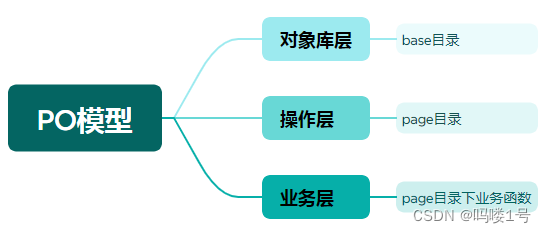
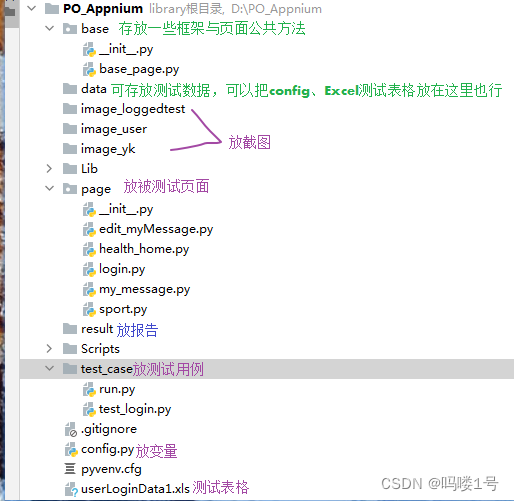

二、base目录与page目录关联:
 三、 base目录下的其他函数:
三、 base目录下的其他函数:
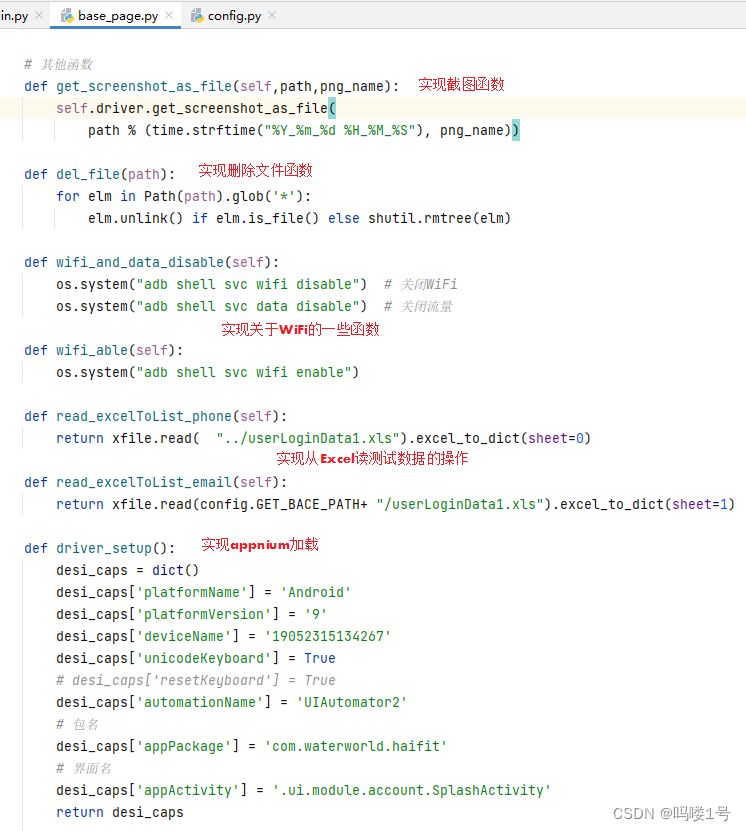
四、page目录login.py下一些注意点:
最后源码:
base_page.py:
import os
import time
from appium import webdriver
from appium.webdriver.webdriver import By
from selenium.webdriver.support.wait import WebDriverWait
from appium.webdriver.common.touch_action import TouchAction
from selenium.webdriver import ActionChains
from selenium.webdriver.common.keys import Keys
import pytest
from xToolkit import xfile
import shutil
from pathlib import Path
import config
class BasePage:
def __init__(self,driver):
self.driver = driver
# 查找元素
def find_el_by_id(self,id,time =15,frequency=0.1):
return WebDriverWait(self.driver,time,frequency).until(
lambda x: x.find_element(By.ID, id) )
def find_el_by_uiautomator_text(self,el_text,time=18 , frequency=0.01):
return WebDriverWait(self.driver, time, frequency).until(
lambda x: x.find_element(By.ANDROID_UIAUTOMATOR, "new UiSelector().text(\"" + el_text + "\")"))
def find_el_by_uiautomator_contains(self,el_text ,time=15 , frequency=0.1):
return WebDriverWait(self.driver,time, frequency).until(
lambda x:x.find_element(By.ANDROID_UIAUTOMATOR,"new UiSelector().textContains(\"" + el_text + "\")"))
def find_toast(self,text_result,time=6 , frequency=0.01):
return WebDriverWait(self.driver, time, frequency).until(
lambda x: x.find_element(By.XPATH, '//*[contains(@text, "%s")]' % text_result))
# 其他函数
def get_screenshot_as_file(self,path,png_name):
self.driver.get_screenshot_as_file(
"../"+path +"/%s%s.png" % (time.strftime("%Y_%m_%d %H_%M_%S"), png_name))
def del_file(path):
for elm in Path(path).glob('*'):
elm.unlink() if elm.is_file() else shutil.rmtree(elm)
def wifi_and_data_disable(self):
os.system("adb shell svc wifi disable") # 关闭WiFi
os.system("adb shell svc data disable") # 关闭流量
def wifi_able(self):
os.system("adb shell svc wifi enable")
def read_excelToList_phone(self):
return xfile.read( "../userLoginData1.xls").excel_to_dict(sheet=0)
def read_excelToList_email(self):
return xfile.read(config.GET_BACE_PATH+ "/userLoginData1.xls").excel_to_dict(sheet=1)
def back(self):
self.driver.press_keycode(4) #返回
def driver_setup():
desi_caps = dict()
desi_caps['platformName'] = 'Android'
desi_caps['platformVersion'] = '9'
desi_caps['deviceName'] = '19052315134267'
desi_caps['unicodeKeyboard'] = True
desi_caps['resetKeyboard'] = True
desi_caps['automationName'] = 'UIAutomator2'
# 包名
desi_caps['appPackage'] = 'com.waterworld.haifit'
# 界面名
desi_caps['appActivity'] = '.ui.module.account.SplashActivity'
return desi_caps
def driver_setup_noReset():
desi_caps = dict()
desi_caps['platformName'] = 'Android'
desi_caps['platformVersion'] = '9'
desi_caps['deviceName'] = '19052315134267'
desi_caps['unicodeKeyboard'] = True
desi_caps['resetKeyboard'] = True
desi_caps['noReset'] = True
desi_caps['automationName'] = 'UIAutomator2'
# 包名
desi_caps['appPackage'] = 'com.waterworld.haifit'
# 界面名
desi_caps['appActivity'] = '.ui.module.account.SplashActivity'
return desi_caps
config.py:
import os
from xToolkit import xfile
#设置项目环境域名
path_user = r'D:\PO_Appnium\image_user' # 输入文件夹地址
agreement = "com.waterworld.haifit:id/tv_dialog_agreement_right"
send_name = "youke_test"
defult_nichen = "HaFit"
test_nichen = defult_nichen +"_test"
confirm ="确认"
permit = "允许"
visitor_login = "游客登录"
finish = "com.waterworld.haifit:id/mbtn_complete"
mine = "我的"
log_out = "退出登录"
visible = "com.waterworld.haifit:id/cb_login_password_is_visible"
tap_the_phone = "com.waterworld.haifit:id/tv_title_left"
tap_emali = "com.waterworld.haifit:id/tv_title_right"
account_phone = "com.waterworld.haifit:id/et_account_phone"
account_email = "com.waterworld.haifit:id/et_account_email"
input_psw = "com.waterworld.haifit:id/medt_input_psw"
#账号登录按钮
enter = "com.waterworld.haifit:id/mbtn_login"
phone_num = #####
password_num = "###"
#-------运动
turn_sport = "com.waterworld.haifit:id/rb_main_sport"
GO = "com.waterworld.haifit:id/iv_sport_start"
sport_pause = "com.waterworld.haifit:id/view_start_sport_pause"
start_sport_map = "com.waterworld.haifit:id/iv_start_sport_map"
sport_time = "时长"
start_sport_close = "com.waterworld.haifit:id/iv_start_sport_close"
start_sport_stop = "com.waterworld.haifit:id/view_start_sport_stop"
sport_end = "结束运动"
running = "跑步"
walking = "健走"
climbing = "登山"
sport_png_path = "image_loggedtest"
#-----健康--------------------
health_habit = "健康习惯"
drink_water_frequently = "勤喝水"
#获取根目录,参数__file__指的是当前文件的目录,config位于根目录下,所以返回值就是根目录(当前文件的目录)
GET_BACE_PATH = os.path.dirname(__file__)
print(GET_BACE_PATH)
print("------")
phone_list = xfile.read(GET_BACE_PATH + "/userLoginData1.xls").excel_to_dict(sheet=0)
print(phone_list)login.py:
import time
import config
from base.base_page import BasePage
class LoginPage(BasePage):
#同意
def agreement(self):
time.sleep(15)
self.find_el_by_id(config.agreement).click()
def confirm(self):
self.find_el_by_uiautomator_text(config.confirm).click()
def permit(self):
self.find_el_by_uiautomator_text(config.permit).click()
def find_el_by_id_and_click(self,el_id,time =15, frequency =0.1):
self.find_el_by_id(el_id,time,frequency).click()
def find_el_by_uiautomator_text_click(self, el_text ,time =18, frequency =0.01):
self.find_el_by_uiautomator_text(el_text,time,frequency).click()
def find_el_by_id_sendkeys(self,id,data,time =15, frequency =0.1):
self.find_el_by_id(id,time =15, frequency =0.1).send_keys(data)
#---------退出登录--
def loginoff(self):
print("进入退出登录--")
self.find_el_by_uiautomator_text_click(config.mine)
self.find_el_by_uiautomator_text_click(config.log_out)
self.confirm()
print("---登录状态退出")
#------------------------------进入账号登录环节-----------------------------------------
def input_testdata(self,data_list,user_id,password_id):
# 可见密码
print("开始测了--11")
self.find_el_by_id_and_click(config.visible)
print("密码已经设置为可见--")
for i in data_list:
text_result = i.get("预期结果")
print("1`1```1")
self.find_el_by_id_sendkeys(user_id, i.get("账号"))
time.sleep(1)
print("--账号已输入--")
self.find_el_by_id_sendkeys(password_id, i.get("密码"))
time.sleep(1)
print("--密码已输入--")
if i.get("预期结果") == "不可点" or i.get("预期结果") == "登录成功":
print("是不可点或者登录成功")
self.find_el_by_id_and_click(config.enter)
time.sleep(4)
if i.get("预期结果") == "登陆成功":
time.sleep(2)
self.get_screenshot_as_file("../image_user/%s%s.png", text_result)
time.sleep(2)
else:
# text模糊定位
print("-----------------登录错误提示:")
self.find_el_by_id_and_click(config.enter)
print("已经点击登录了 -----")
element = self.find_toast(text_result)
self.get_screenshot_as_file("../image_user/%s%s .png", element.text)
if element.text == text_result:
print("%s,结果一致" % i.get("预期结果"))
time.sleep(2)
#---------组合业务01--游客登录后退出-----------
def do_visitor_login_nowifi(self):
self.agreement()
self.wifi_and_data_disable()
print("已关闭WiFi和流量")
# self.visitor_login()
self.find_el_by_uiautomator_text_click(config.visitor_login)
print("已选择游客登录")
self.confirm()
self.permit()
self.find_el_by_id_and_click(config.finish)
self.loginoff()
time.sleep(1)
print("已退出登录--")
def do_visitor_login(self):
self.agreement()
self.wifi_able()
print("开启WiFi")
# self.visitor_login()
self.find_el_by_uiautomator_text_click(config.visitor_login)
print("已选择游客登录")
self.confirm()
self.permit()
self.find_el_by_id_and_click(config.finish)
self.loginoff()
time.sleep(1)
print("已退出登录--")
#----------组合业务02----用户登录后退出---******--------------------
def do_user_login_phone(self):
self.wifi_able()
print("开始test了,先选择手机登录:")
self.find_el_by_id_and_click(config.tap_the_phone)
print("已切换到手机登录-------------")
self.input_testdata(self.read_excelToList_phone() ,config.account_phone, config.input_psw)
self.loginoff()
def do_user_login_email(self):
print("$$$$$$切换到邮箱$$$$$$$$")
self.find_el_by_id_and_click(config.tap_emali)
print("-----------进入邮箱登录")
self.input_testdata(self.read_excelToList_email(), config.account_email, config.input_psw)
self.loginoff()
time.sleep(1)
print("+++==============登录模块测试完毕==============+++")
#---------组合业务03--用户登录keep-----------
def keep_user_login(self):
self.find_el_by_id_and_click(config.tap_the_phone)
self.find_el_by_id_sendkeys(config.account_phone, config.phone_num)
self.find_el_by_id_sendkeys(config.input_psw, config.password_num)
self.find_el_by_id_and_click(config.enter)
def keep_visitor_login(self):
self.wifi_able()
print("游客登录已开启WiFi--")
self.find_el_by_uiautomator_text_click(config.visitor_login)
test_alogin.py:
import unittest
import base.base_page
from appium import webdriver
from base.base_page import BasePage
from page.login import LoginPage
import config
import time
#为了先测
class TestALogin(unittest.TestCase):
def setUp(self):
self.driver = webdriver.Remote('http://localhost:4723/wd/hub',BasePage.driver_setup() )
# self.base_page = BasePage(driver = self.driver)
self.base_page = BasePage(driver = self.driver)
self.login_page = LoginPage(driver = self.driver)
def test_alogin_reset_yk(self):
try:
BasePage.del_file(config.path_image_user)
print("已删除文件截图---------------")
self.login_page.do_visitor_login()
self.login_page.do_user_login_phone()
self.login_page.do_user_login_email()
except Exception as e:
return e
def tearDown(self):
self.driver.quit()
time.sleep(5)
if __name__ == "__main__":
unittest.main()
test_alogin_yk_reset.py:
import unittest
import base.base_page
from appium import webdriver
from base.base_page import BasePage
from page.login import LoginPage
import config
import time
class TestALoginResetYK(unittest.TestCase):
def setUp(self):
self.driver = webdriver.Remote('http://localhost:4723/wd/hub',BasePage.driver_setup() )
# self.base_page = BasePage(driver = self.driver)
self.base_page = BasePage(driver = self.driver)
self.login_page = LoginPage(driver = self.driver)
def test_login(self):
try:
BasePage.del_file(config.path_image_user)
print("已删除文件截图---------------")
self.login_page.do_visitor_login()
# self.login_page.do_user_login_phone()
# self.login_page.do_user_login_email()
except Exception as e:
return e
def tearDown(self):
self.driver.quit()
time.sleep(5)
if __name__ == "__main__":
unittest.main()
---------------------------
sport.py:
import time
from appium.webdriver.common.touch_action import TouchAction
from selenium.webdriver import ActionChains
from selenium.webdriver.common.keys import Keys
import config
from base.base_page import BasePage
class SportPage(BasePage):
def confirm(self):
self.find_el_by_uiautomator_text(config.confirm).click()
def permit(self):
self.find_el_by_uiautomator_text(config.permit).click()
def find_el_by_id_and_click(self,el_id,time =15, frequency =0.1):
self.find_el_by_id(el_id,time,frequency).click()
def find_el_by_uiautomator_text_click(self, el_text ,time =18, frequency =0.01):
self.find_el_by_uiautomator_text(el_text,time,frequency).click()
def find_el_by_id_sendkeys(self,id,data,time =15, frequency =0.1):
self.find_el_by_id(id,time =15, frequency =0.1).send_keys(data)
def turn_sport(self):
self.find_el_by_id_and_click(config.turn_sport)
def sport_first(self,path,xingshi):
print("进入GO---")
time.sleep(3)
self.find_el_by_id_and_click(config.GO)
self.confirm()
self.permit()
self.find_el_by_id_and_click(config.GO)
self.permit()
self.find_el_by_id_and_click(config.GO)
print("长按:")
# 长按 跑步
long_pause = self.find_el_by_id(config.sport_pause)
print("已暂停")
TouchAction(self.driver).long_press(long_pause, duration=5000).release().perform()
print("已暂停")
print("进入地图====")
time.sleep(3)
self.find_el_by_id_and_click(config.start_sport_map)
print("切换到地图----")
time.sleep(4)
self.get_screenshot_as_file(path, xingshi)
print("运动地图已截图%%%%")
self.find_el_by_id_and_click(config.start_sport_close) # 叉掉
long_stop = self.find_el_by_id(config.start_sport_stop)
TouchAction(self.driver).long_press(long_stop, duration=5000).release().perform()
self.find_el_by_uiautomator_text_click(config.sport_end)
time.sleep(1)
print("-------------*******----------------")
def sport(self,path, xingshi):
print("进入GO---")
time.sleep(3)
self.find_el_by_id_and_click(config.GO)
print("长按:")
# 长按 跑步
long_pause = self.find_el_by_id(config.sport_pause)
print("已暂停")
TouchAction(self.driver).long_press(long_pause, duration=5000).release().perform()
print("已暂停--")
time.sleep(3)
self.find_el_by_id_and_click(config.start_sport_map,18) #地图
print("---已切换到地图--")
time.sleep(4)
self.get_screenshot_as_file(path, xingshi)
print("运动地图已截图%%%%")
self.find_el_by_id_and_click(config.start_sport_close) # 叉掉
long_stop = self.find_el_by_id(config.start_sport_stop)
TouchAction(self.driver).long_press(long_stop, duration=5000).release().perform()
self.find_el_by_uiautomator_text_click(config.sport_end)
time.sleep(1)
print("-------------*******----------------")
def do_sport(self):
self.turn_sport()
self.sport(config.sport_png_path,config.running)
self.sport(config.sport_png_path ,config.walking)
self.sport(config.sport_png_path, config.climbing)
def do_sport_first(self):
self.turn_sport()
self.sport_first(config.sport_png_path, config.running)
self.sport(config.sport_png_path, config.walking)
self.sport(config.sport_png_path, config.climbing)test_sport.py:
import unittest
from page.login import LoginPage
import config
from appium import webdriver
from base.base_page import BasePage
import base.base_page
from page.sport import SportPage
class TestSport(unittest.TestCase):
def setUp(self):
self.driver = webdriver.Remote('http://localhost:4723/wd/hub',BasePage.driver_setup_noReset() )
self.base_page = BasePage(driver = self.driver)
self.login_page = LoginPage(driver = self.driver)
self.sport_page = SportPage(driver = self.driver)
# def test_visitor_sport_first(self):
# self.login_page.keep_visitor_login()
# self.sport_page.do_sport_first()
# self.login_page.loginoff()
def test_sport(self):
self.login_page.keep_visitor_login()
self.sport_page.do_sport()
self.login_page.loginoff()
self.login_page.keep_user_login()
self.sport_page.do_sport()
self.login_page.loginoff()
# def tearDown(self):
# self.driver.quit()
if __name__ == "__main__":
unittest.main()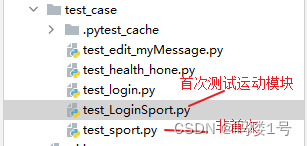
test_LoginSport.py:
---------------------------
health_home.py:
import time
import config
from base.base_page import BasePage
class HealthHonePage(BasePage):
def find_el_by_id_and_click(self,el_id,time =15, frequency =0.1):
self.find_el_by_id(el_id,time,frequency).click()
def find_el_by_uiautomator_text_click(self, el_text ,time =18, frequency =0.01):
self.find_el_by_uiautomator_text(el_text,time,frequency).click()
def find_el_by_id_sendkeys(self,id,data,time =15, frequency =0.1):
self.find_el_by_id(id,time =15, frequency =0.1).send_keys(data)
def do_health_home(self):
print("已切换到“健康页面-----:”")
self.find_el_by_uiautomator_text_click(config.health_habit)
self.find_el_by_uiautomator_text_click(config.drink_water_frequently)
print("找到了 勤喝水")
self.back()test_health_home.py:
import unittest
from page.login import LoginPage
import config
from appium import webdriver
from base.base_page import BasePage
import base.base_page
from page.health_home import HealthHonePage
class TestHealthHome(unittest.TestCase):
def setUp(self):
self.driver = webdriver.Remote('http://localhost:4723/wd/hub',BasePage.driver_setup_noReset() )
self.base_page = BasePage(driver = self.driver)
self.login_page = LoginPage(driver = self.driver)
self.health_page = HealthHonePage(driver = self.driver)
def test_health_home(self):
self.login_page.keep_visitor_login()
self.health_page.do_health_home()
self.login_page.loginoff()
self.login_page.keep_user_login()
self.health_page.do_health_home()
self.login_page.loginoff()
if __name__ == "__main__":
unittest.main()PC运行结果截图:
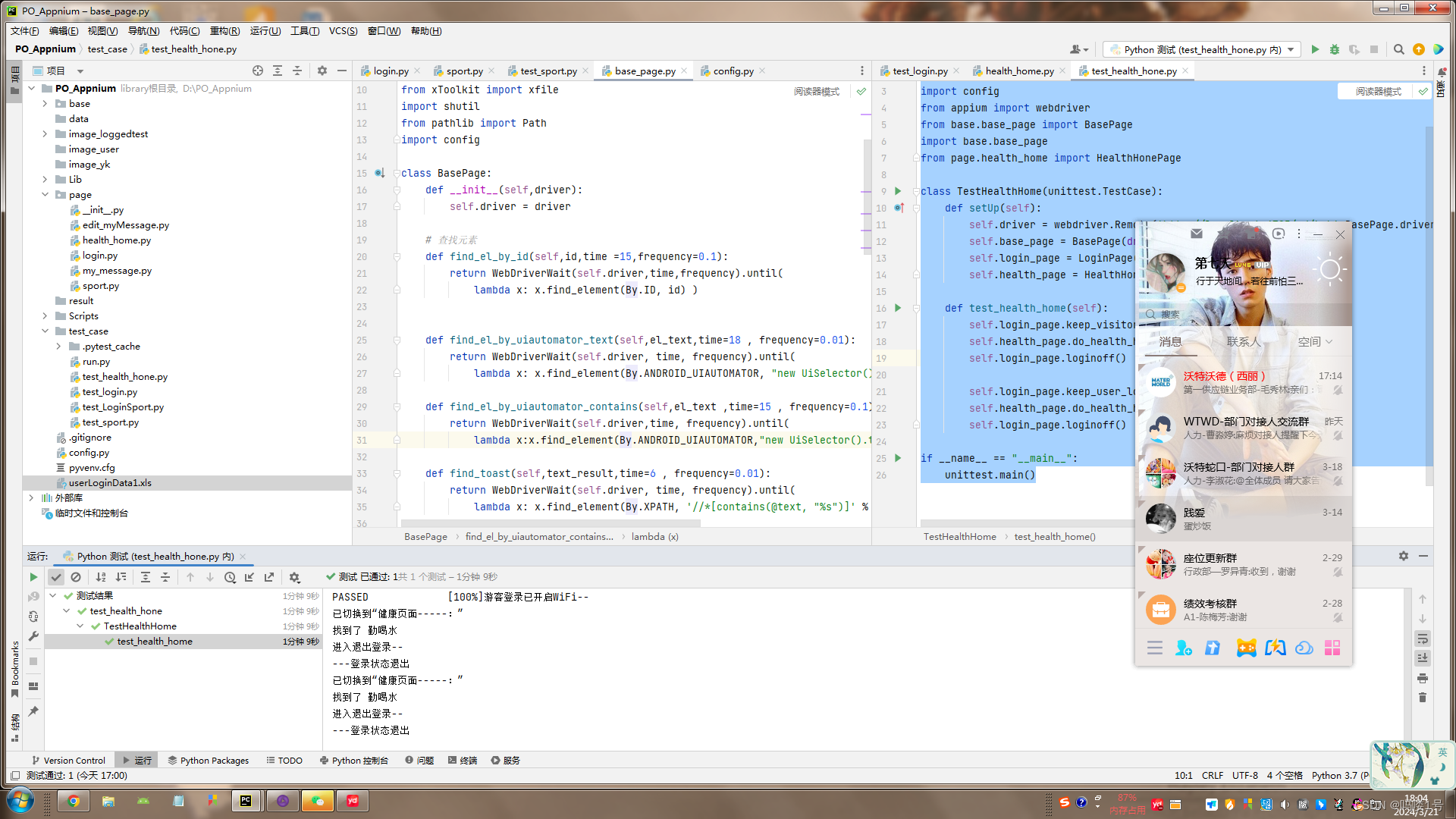
----------------------------
*生成HTMLTestRunner.html报告的配置:
1、HTMLTestRunner.py(适用于python3.x)如下,把文件放入python对应版本Lib目录下:
"""
A TestRunner for use with the Python unit testing framework. It
generates a HTML report to show the result at a glance.
The simplest way to use this is to invoke its main method. E.g.
import unittest
import HTMLTestRunner
... define your tests ...
if __name__ == '__main__':
HTMLTestRunner.main()
For more customization options, instantiates a HTMLTestRunner object.
HTMLTestRunner is a counterpart to unittest's TextTestRunner. E.g.
# output to a file
fp = file('my_report.html', 'wb')
runner = HTMLTestRunner.HTMLTestRunner(
stream=fp,
title='My unit test',
description='This demonstrates the report output by HTMLTestRunner.'
)
# Use an external stylesheet.
# See the Template_mixin class for more customizable options
runner.STYLESHEET_TMPL = '<link rel="stylesheet" href="my_stylesheet.css" type="text/css">'
# run the test
runner.run(my_test_suite)
------------------------------------------------------------------------
Copyright (c) 2004-2007, Wai Yip Tung
All rights reserved.
Redistribution and use in source and binary forms, with or without
modification, are permitted provided that the following conditions are
met:
* Redistributions of source code must retain the above copyright notice,
this list of conditions and the following disclaimer.
* Redistributions in binary form must reproduce the above copyright
notice, this list of conditions and the following disclaimer in the
documentation and/or other materials provided with the distribution.
* Neither the name Wai Yip Tung nor the names of its contributors may be
used to endorse or promote products derived from this software without
specific prior written permission.
THIS SOFTWARE IS PROVIDED BY THE COPYRIGHT HOLDERS AND CONTRIBUTORS "AS
IS" AND ANY EXPRESS OR IMPLIED WARRANTIES, INCLUDING, BUT NOT LIMITED
TO, THE IMPLIED WARRANTIES OF MERCHANTABILITY AND FITNESS FOR A
PARTICULAR PURPOSE ARE DISCLAIMED. IN NO EVENT SHALL THE COPYRIGHT OWNER
OR CONTRIBUTORS BE LIABLE FOR ANY DIRECT, INDIRECT, INCIDENTAL, SPECIAL,
EXEMPLARY, OR CONSEQUENTIAL DAMAGES (INCLUDING, BUT NOT LIMITED TO,
PROCUREMENT OF SUBSTITUTE GOODS OR SERVICES; LOSS OF USE, DATA, OR
PROFITS; OR BUSINESS INTERRUPTION) HOWEVER CAUSED AND ON ANY THEORY OF
LIABILITY, WHETHER IN CONTRACT, STRICT LIABILITY, OR TORT (INCLUDING
NEGLIGENCE OR OTHERWISE) ARISING IN ANY WAY OUT OF THE USE OF THIS
SOFTWARE, EVEN IF ADVISED OF THE POSSIBILITY OF SUCH DAMAGE.
"""
# URL: http://tungwaiyip.info/software/HTMLTestRunner.html
__author__ = "Wai Yip Tung"
__version__ = "0.8.2"
"""
Change History
Version 0.8.2
* Show output inline instead of popup window (Viorel Lupu).
Version in 0.8.1
* Validated XHTML (Wolfgang Borgert).
* Added description of test classes and test cases.
Version in 0.8.0
* Define Template_mixin class for customization.
* Workaround a IE 6 bug that it does not treat <script> block as CDATA.
Version in 0.7.1
* Back port to Python 2.3 (Frank Horowitz).
* Fix missing scroll bars in detail log (Podi).
"""
# TODO: color stderr
# TODO: simplify javascript using ,ore than 1 class in the class attribute?
import datetime
import io
import sys
import time
import unittest
from xml.sax import saxutils
# ------------------------------------------------------------------------
# The redirectors below are used to capture output during testing. Output
# sent to sys.stdout and sys.stderr are automatically captured. However
# in some cases sys.stdout is already cached before HTMLTestRunner is
# invoked (e.g. calling logging.basicConfig). In order to capture those
# output, use the redirectors for the cached stream.
#
# e.g.
# >>> logging.basicConfig(stream=HTMLTestRunner.stdout_redirector)
# >>>
class OutputRedirector(object):
""" Wrapper to redirect stdout or stderr """
def __init__(self, fp):
self.fp = fp
def write(self, s):
self.fp.write(s)
def writelines(self, lines):
self.fp.writelines(lines)
def flush(self):
self.fp.flush()
stdout_redirector = OutputRedirector(sys.stdout)
stderr_redirector = OutputRedirector(sys.stderr)
# ----------------------------------------------------------------------
# Template
class Template_mixin(object):
"""
Define a HTML template for report customerization and generation.
Overall structure of an HTML report
HTML
+------------------------+
|<html> |
| <head> |
| |
| STYLESHEET |
| +----------------+ |
| | | |
| +----------------+ |
| |
| </head> |
| |
| <body> |
| |
| HEADING |
| +----------------+ |
| | | |
| +----------------+ |
| |
| REPORT |
| +----------------+ |
| | | |
| +----------------+ |
| |
| ENDING |
| +----------------+ |
| | | |
| +----------------+ |
| |
| </body> |
|</html> |
+------------------------+
"""
STATUS = {
0: 'pass',
1: 'fail',
2: 'error',
}
DEFAULT_TITLE = 'Unit Test Report'
DEFAULT_DESCRIPTION = ''
# ------------------------------------------------------------------------
# HTML Template
HTML_TMPL = r"""<?xml version="1.0" encoding="UTF-8"?>
<!DOCTYPE html PUBLIC "-//W3C//DTD XHTML 1.0 Strict//EN" "http://www.w3.org/TR/xhtml1/DTD/xhtml1-strict.dtd">
<html xmlns="http://www.w3.org/1999/xhtml">
<head>
<title>%(title)s</title>
<meta name="generator" content="%(generator)s"/>
<meta http-equiv="Content-Type" content="text/html; charset=UTF-8"/>
%(stylesheet)s
</head>
<body>
<script language="javascript" type="text/javascript"><!--
output_list = Array();
/* level - 0:Summary; 1:Failed; 2:All */
function showCase(level) {
trs = document.getElementsByTagName("tr");
for (var i = 0; i < trs.length; i++) {
tr = trs[i];
id = tr.id;
if (id.substr(0,2) == 'ft') {
if (level < 1) {
tr.className = 'hiddenRow';
}
else {
tr.className = '';
}
}
if (id.substr(0,2) == 'pt') {
if (level > 1) {
tr.className = '';
}
else {
tr.className = 'hiddenRow';
}
}
}
}
function showClassDetail(cid, count) {
var id_list = Array(count);
var toHide = 1;
for (var i = 0; i < count; i++) {
tid0 = 't' + cid.substr(1) + '.' + (i+1);
tid = 'f' + tid0;
tr = document.getElementById(tid);
if (!tr) {
tid = 'p' + tid0;
tr = document.getElementById(tid);
}
id_list[i] = tid;
if (tr.className) {
toHide = 0;
}
}
for (var i = 0; i < count; i++) {
tid = id_list[i];
if (toHide) {
document.getElementById('div_'+tid).style.display = 'none'
document.getElementById(tid).className = 'hiddenRow';
}
else {
document.getElementById(tid).className = '';
}
}
}
function showTestDetail(div_id){
var details_div = document.getElementById(div_id)
var displayState = details_div.style.display
// alert(displayState)
if (displayState != 'block' ) {
displayState = 'block'
details_div.style.display = 'block'
}
else {
details_div.style.display = 'none'
}
}
function html_escape(s) {
s = s.replace(/&/g,'&');
s = s.replace(/</g,'<');
s = s.replace(/>/g,'>');
return s;
}
/* obsoleted by detail in <div>
function showOutput(id, name) {
var w = window.open("", //url
name,
"resizable,scrollbars,status,width=800,height=450");
d = w.document;
d.write("<pre>");
d.write(html_escape(output_list[id]));
d.write("\n");
d.write("<a href='javascript:window.close()'>close</a>\n");
d.write("</pre>\n");
d.close();
}
*/
--></script>
%(heading)s
%(report)s
%(ending)s
</body>
</html>
"""
# variables: (title, generator, stylesheet, heading, report, ending)
# ------------------------------------------------------------------------
# Stylesheet
#
# alternatively use a <link> for external style sheet, e.g.
# <link rel="stylesheet" href="$url" type="text/css">
STYLESHEET_TMPL = """
<style type="text/css" media="screen">
body { font-family: verdana, arial, helvetica, sans-serif; font-size: 80%; }
table { font-size: 100%; }
pre { }
/* -- heading ---------------------------------------------------------------------- */
h1 {
font-size: 16pt;
color: gray;
}
.heading {
margin-top: 0ex;
margin-bottom: 1ex;
}
.heading .attribute {
margin-top: 1ex;
margin-bottom: 0;
}
.heading .description {
margin-top: 4ex;
margin-bottom: 6ex;
}
/* -- css div popup ------------------------------------------------------------------------ */
a.popup_link {
}
a.popup_link:hover {
color: red;
}
.popup_window {
display: none;
position: relative;
left: 0px;
top: 0px;
/*border: solid #627173 1px; */
padding: 10px;
background-color: #E6E6D6;
font-family: "Lucida Console", "Courier New", Courier, monospace;
text-align: left;
font-size: 8pt;
width: 500px;
}
}
/* -- report ------------------------------------------------------------------------ */
#show_detail_line {
margin-top: 3ex;
margin-bottom: 1ex;
}
#result_table {
width: 80%;
border-collapse: collapse;
border: 1px solid #777;
}
#header_row {
font-weight: bold;
color: white;
background-color: #777;
}
#result_table td {
border: 1px solid #777;
padding: 2px;
}
#total_row { font-weight: bold; }
.passClass { background-color: #6c6; }
.failClass { background-color: #c60; }
.errorClass { background-color: #c00; }
.passCase { color: #6c6; }
.failCase { color: #c60; font-weight: bold; }
.errorCase { color: #c00; font-weight: bold; }
.hiddenRow { display: none; }
.testcase { margin-left: 2em; }
/* -- ending ---------------------------------------------------------------------- */
#ending {
}
</style>
"""
# ------------------------------------------------------------------------
# Heading
#
HEADING_TMPL = """<div class='heading'>
<h1>%(title)s</h1>
%(parameters)s
<p class='description'>%(description)s</p>
</div>
""" # variables: (title, parameters, description)
HEADING_ATTRIBUTE_TMPL = """<p class='attribute'><strong>%(name)s:</strong> %(value)s</p>
""" # variables: (name, value)
# ------------------------------------------------------------------------
# Report
#
REPORT_TMPL = """
<p id='show_detail_line'>Show
<a href='javascript:showCase(0)'>Summary</a>
<a href='javascript:showCase(1)'>Failed</a>
<a href='javascript:showCase(2)'>All</a>
</p>
<table id='result_table'>
<colgroup>
<col align='left' />
<col align='right' />
<col align='right' />
<col align='right' />
<col align='right' />
<col align='right' />
</colgroup>
<tr id='header_row'>
<td>Test Group/Test case</td>
<td>Count</td>
<td>Pass</td>
<td>Fail</td>
<td>Error</td>
<td>View</td>
</tr>
%(test_list)s
<tr id='total_row'>
<td>Total</td>
<td>%(count)s</td>
<td>%(Pass)s</td>
<td>%(fail)s</td>
<td>%(error)s</td>
<td> </td>
</tr>
</table>
""" # variables: (test_list, count, Pass, fail, error)
REPORT_CLASS_TMPL = r"""
<tr class='%(style)s'>
<td>%(desc)s</td>
<td>%(count)s</td>
<td>%(Pass)s</td>
<td>%(fail)s</td>
<td>%(error)s</td>
<td><a href="javascript:showClassDetail('%(cid)s',%(count)s)">Detail</a></td>
</tr>
""" # variables: (style, desc, count, Pass, fail, error, cid)
REPORT_TEST_WITH_OUTPUT_TMPL = r"""
<tr id='%(tid)s' class='%(Class)s'>
<td class='%(style)s'><div class='testcase'>%(desc)s</div></td>
<td colspan='5' align='center'>
<!--css div popup start-->
<a class="popup_link" onfocus='this.blur();' href="javascript:showTestDetail('div_%(tid)s')" >
%(status)s</a>
<div id='div_%(tid)s' class="popup_window">
<div style='text-align: right; color:red;cursor:pointer'>
<a onfocus='this.blur();' onclick="document.getElementById('div_%(tid)s').style.display = 'none' " >
[x]</a>
</div>
<pre>
%(script)s
</pre>
</div>
<!--css div popup end-->
</td>
</tr>
""" # variables: (tid, Class, style, desc, status)
REPORT_TEST_NO_OUTPUT_TMPL = r"""
<tr id='%(tid)s' class='%(Class)s'>
<td class='%(style)s'><div class='testcase'>%(desc)s</div></td>
<td colspan='5' align='center'>%(status)s</td>
</tr>
""" # variables: (tid, Class, style, desc, status)
REPORT_TEST_OUTPUT_TMPL = r"""
%(id)s: %(output)s
""" # variables: (id, output)
# ------------------------------------------------------------------------
# ENDING
#
ENDING_TMPL = """<div id='ending'> </div>"""
# -------------------- The end of the Template class -------------------
TestResult = unittest.TestResult
class _TestResult(TestResult):
# note: _TestResult is a pure representation of results.
# It lacks the output and reporting ability compares to unittest._TextTestResult.
def __init__(self, verbosity=1):
TestResult.__init__(self)
self.stdout0 = None
self.stderr0 = None
self.success_count = 0
self.failure_count = 0
self.error_count = 0
self.verbosity = verbosity
# result is a list of result in 4 tuple
# (
# result code (0: success; 1: fail; 2: error),
# TestCase object,
# Test output (byte string),
# stack trace,
# )
self.result = []
def startTest(self, test):
TestResult.startTest(self, test)
# just one buffer for both stdout and stderr
self.outputBuffer = io.StringIO()
stdout_redirector.fp = self.outputBuffer
stderr_redirector.fp = self.outputBuffer
self.stdout0 = sys.stdout
self.stderr0 = sys.stderr
sys.stdout = stdout_redirector
sys.stderr = stderr_redirector
def complete_output(self):
"""
Disconnect output redirection and return buffer.
Safe to call multiple times.
"""
if self.stdout0:
sys.stdout = self.stdout0
sys.stderr = self.stderr0
self.stdout0 = None
self.stderr0 = None
return self.outputBuffer.getvalue()
def stopTest(self, test):
# Usually one of addSuccess, addError or addFailure would have been called.
# But there are some path in unittest that would bypass this.
# We must disconnect stdout in stopTest(), which is guaranteed to be called.
self.complete_output()
def addSuccess(self, test):
self.success_count += 1
TestResult.addSuccess(self, test)
output = self.complete_output()
self.result.append((0, test, output, ''))
if self.verbosity > 1:
sys.stderr.write('ok ')
sys.stderr.write(str(test))
sys.stderr.write('\n')
else:
sys.stderr.write('.')
def addError(self, test, err):
self.error_count += 1
TestResult.addError(self, test, err)
_, _exc_str = self.errors[-1]
output = self.complete_output()
self.result.append((2, test, output, _exc_str))
if self.verbosity > 1:
sys.stderr.write('E ')
sys.stderr.write(str(test))
sys.stderr.write('\n')
else:
sys.stderr.write('E')
def addFailure(self, test, err):
self.failure_count += 1
TestResult.addFailure(self, test, err)
_, _exc_str = self.failures[-1]
output = self.complete_output()
self.result.append((1, test, output, _exc_str))
if self.verbosity > 1:
sys.stderr.write('F ')
sys.stderr.write(str(test))
sys.stderr.write('\n')
else:
sys.stderr.write('F')
class HTMLTestRunner(Template_mixin):
"""
"""
def __init__(self, stream=sys.stdout, verbosity=1, title=None, description=None):
self.stream = stream
self.verbosity = verbosity
if title is None:
self.title = self.DEFAULT_TITLE
else:
self.title = title
if description is None:
self.description = self.DEFAULT_DESCRIPTION
else:
self.description = description
self.startTime = datetime.datetime.now()
def run(self, test):
"Run the given test case or test suite."
result = _TestResult(self.verbosity)
test(result)
self.stopTime = datetime.datetime.now()
self.generateReport(test, result)
# print >> sys.stderr, '\nTime Elapsed: %s' % (self.stopTime-self.startTime)
print(sys.stderr, '\nTime Elapsed: %s' % (self.stopTime-self.startTime))
return result
def sortResult(self, result_list):
# unittest does not seems to run in any particular order.
# Here at least we want to group them together by class.
rmap = {}
classes = []
for n,t,o,e in result_list:
cls = t.__class__
if not cls in rmap:
rmap[cls] = []
classes.append(cls)
rmap[cls].append((n,t,o,e))
r = [(cls, rmap[cls]) for cls in classes]
return r
def getReportAttributes(self, result):
"""
Return report attributes as a list of (name, value).
Override this to add custom attributes.
"""
startTime = str(self.startTime)[:19]
duration = str(self.stopTime - self.startTime)
status = []
if result.success_count: status.append('Pass %s' % result.success_count)
if result.failure_count: status.append('Failure %s' % result.failure_count)
if result.error_count: status.append('Error %s' % result.error_count )
if status:
status = ' '.join(status)
else:
status = 'none'
return [
('Start Time', startTime),
('Duration', duration),
('Status', status),
]
def generateReport(self, test, result):
report_attrs = self.getReportAttributes(result)
generator = 'HTMLTestRunner %s' % __version__
stylesheet = self._generate_stylesheet()
heading = self._generate_heading(report_attrs)
report = self._generate_report(result)
ending = self._generate_ending()
output = self.HTML_TMPL % dict(
title = saxutils.escape(self.title),
generator = generator,
stylesheet = stylesheet,
heading = heading,
report = report,
ending = ending,
)
self.stream.write(output.encode('utf8'))
def _generate_stylesheet(self):
return self.STYLESHEET_TMPL
def _generate_heading(self, report_attrs):
a_lines = []
for name, value in report_attrs:
line = self.HEADING_ATTRIBUTE_TMPL % dict(
name = saxutils.escape(name),
value = saxutils.escape(value),
)
a_lines.append(line)
heading = self.HEADING_TMPL % dict(
title = saxutils.escape(self.title),
parameters = ''.join(a_lines),
description = saxutils.escape(self.description),
)
return heading
def _generate_report(self, result):
rows = []
sortedResult = self.sortResult(result.result)
for cid, (cls, cls_results) in enumerate(sortedResult):
# subtotal for a class
np = nf = ne = 0
for n,t,o,e in cls_results:
if n == 0: np += 1
elif n == 1: nf += 1
else: ne += 1
# format class description
if cls.__module__ == "__main__":
name = cls.__name__
else:
name = "%s.%s" % (cls.__module__, cls.__name__)
doc = cls.__doc__ and cls.__doc__.split("\n")[0] or ""
desc = doc and '%s: %s' % (name, doc) or name
row = self.REPORT_CLASS_TMPL % dict(
style = ne > 0 and 'errorClass' or nf > 0 and 'failClass' or 'passClass',
desc = desc,
count = np+nf+ne,
Pass = np,
fail = nf,
error = ne,
cid = 'c%s' % (cid+1),
)
rows.append(row)
for tid, (n,t,o,e) in enumerate(cls_results):
self._generate_report_test(rows, cid, tid, n, t, o, e)
report = self.REPORT_TMPL % dict(
test_list = ''.join(rows),
count = str(result.success_count+result.failure_count+result.error_count),
Pass = str(result.success_count),
fail = str(result.failure_count),
error = str(result.error_count),
)
return report
def _generate_report_test(self, rows, cid, tid, n, t, o, e):
# e.g. 'pt1.1', 'ft1.1', etc
has_output = bool(o or e)
tid = (n == 0 and 'p' or 'f') + 't%s.%s' % (cid+1,tid+1)
name = t.id().split('.')[-1]
doc = t.shortDescription() or ""
desc = doc and ('%s: %s' % (name, doc)) or name
tmpl = has_output and self.REPORT_TEST_WITH_OUTPUT_TMPL or self.REPORT_TEST_NO_OUTPUT_TMPL
# o and e should be byte string because they are collected from stdout and stderr?
if isinstance(o,str):
# TODO: some problem with 'string_escape': it escape \n and mess up formating
# uo = unicode(o.encode('string_escape'))
# uo = o.decode('latin-1')
uo = e
else:
uo = o
if isinstance(e,str):
# TODO: some problem with 'string_escape': it escape \n and mess up formating
# ue = unicode(e.encode('string_escape'))
# ue = e.decode('latin-1')
ue = e
else:
ue = e
script = self.REPORT_TEST_OUTPUT_TMPL % dict(
id = tid,
output = saxutils.escape(str(uo)+ue),
)
row = tmpl % dict(
tid = tid,
Class = (n == 0 and 'hiddenRow' or 'none'),
style = n == 2 and 'errorCase' or (n == 1 and 'failCase' or 'none'),
desc = desc,
script = script,
status = self.STATUS[n],
)
rows.append(row)
if not has_output:
return
def _generate_ending(self):
return self.ENDING_TMPL
##############################################################################
# Facilities for running tests from the command line
##############################################################################
# Note: Reuse unittest.TestProgram to launch test. In the future we may
# build our own launcher to support more specific command line
# parameters like test title, CSS, etc.
class TestProgram(unittest.TestProgram):
"""
A variation of the unittest.TestProgram. Please refer to the base
class for command line parameters.
"""
def runTests(self):
# Pick HTMLTestRunner as the default test runner.
# base class's testRunner parameter is not useful because it means
# we have to instantiate HTMLTestRunner before we know self.verbosity.
if self.testRunner is None:
self.testRunner = HTMLTestRunner(verbosity=self.verbosity)
unittest.TestProgram.runTests(self)
main = TestProgram
##############################################################################
# Executing this module from the command line
##############################################################################
if __name__ == "__main__":
main(module=None)
2、运行测试脚本 后,点击如下导出:

 在浏览器打开即可:
在浏览器打开即可:

3、unittest用例执行顺序:
使用unittest时在多个测试用例下在执行用例 (test_xxx)时,并不是按从上到下的顺序执行,有特定的顺序。unittest框架默认根据ACSII码的顺序加载测试用例,数字与字母的顺序为: 0~9,A~Z,a~z。类和方法都是如此。
=====================
run_login_health_sport.py:
import os
import config
import unittest
import HTMLTestRunner
from test_case.test_health_hone import TestHealthHome
from test_case.test_LoginSport import TestLoginSport
report_file_path = os.path.join(os.getcwd() + '\\result')
result_html_path = os.path.join(report_file_path, 'report_health_sport.html')
print(report_file_path)
print("----")
print(result_html_path)
# 执行指定测试用例
def test_suit():
suit = unittest.TestSuite()
suit.addTest(TestHealthHome("test_health_home"))
suit.addTest(TestLoginSport("test_loginSport"))
return suit
if __name__ == "__main__":
with open(result_html_path, 'wb') as fp:
runner = HTMLTestRunner(stream=fp, title='健康、运动模块测试报告',
description='基于自动化APP测试框架产生的测试报告')
runner.run(test_suit())
运行结果:

HTML报告:
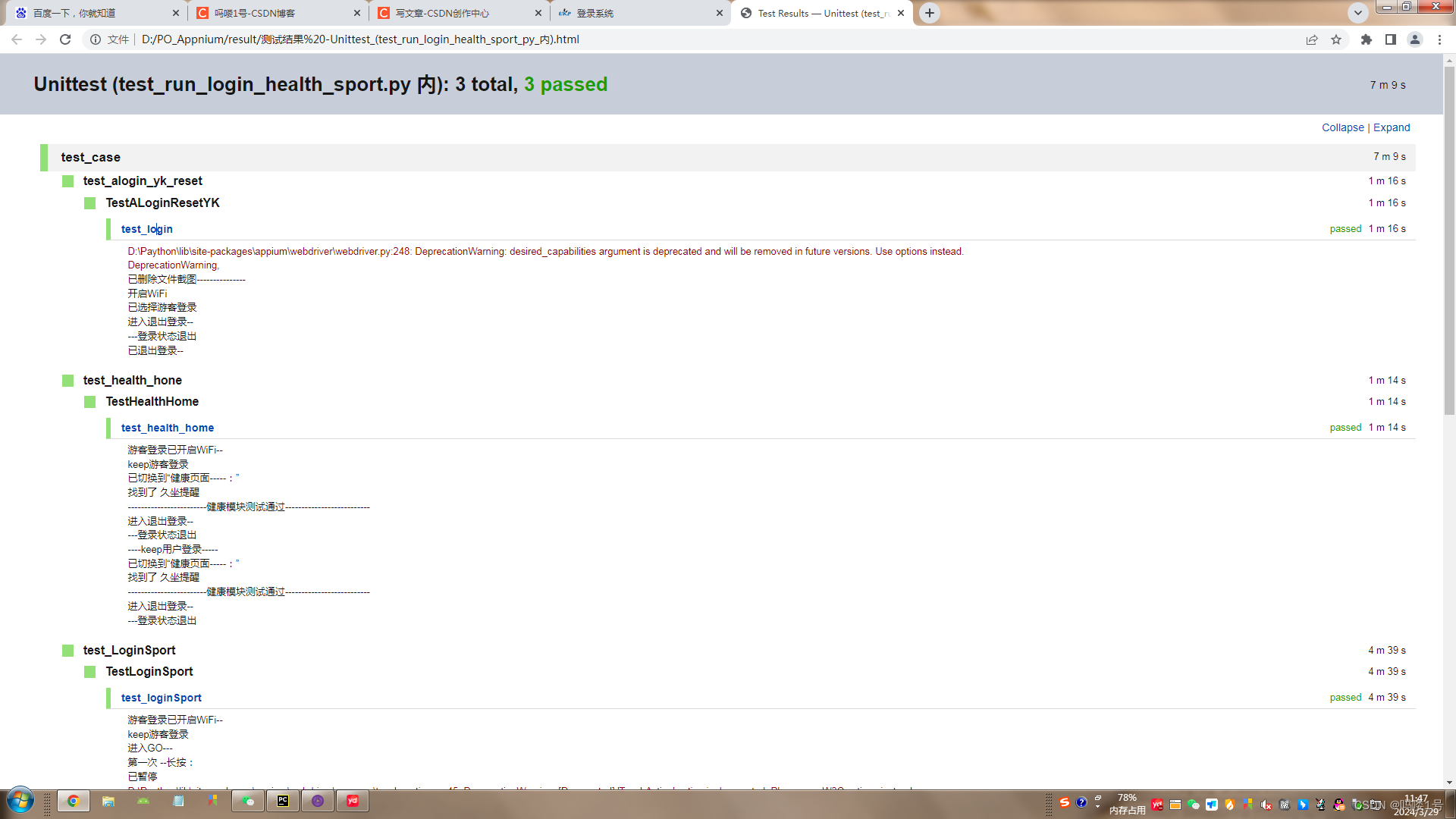
--------------------------------------
run_login_eidt.py:
import os
import config
import unittest
import HTMLTestRunner
from test_case.test_login import TestLogin
from test_case.test_edit_myMessage import TestEditMyMessage
report_file_path = os.path.join(os.getcwd() + '\\result')
result_html_path = os.path.join(report_file_path, 'report_edit.html')
# 执行指定测试用例
def test_suit():
suit = unittest.TestSuite()
suit.addTest(TestLogin("test_login"))
suit.addTest(TestEditMyMessage("test_eidt_myMessage"))
return suit
if __name__ == "__main__":
with open(result_html_path, 'wb') as fp:
# runner = HTMLTestReportCN.HTMLTestRunner(stream=fp, title='登录、修改个人信息模块测试报告',
# description='基于自动化APP测试框架产生的测试报告')
runner = HTMLTestRunner(stream=fp, title='登录、修改个人信息模块测试报告',
description='基于自动化APP测试框架产生的测试报告')
runner.run(test_suit())
运行结果:
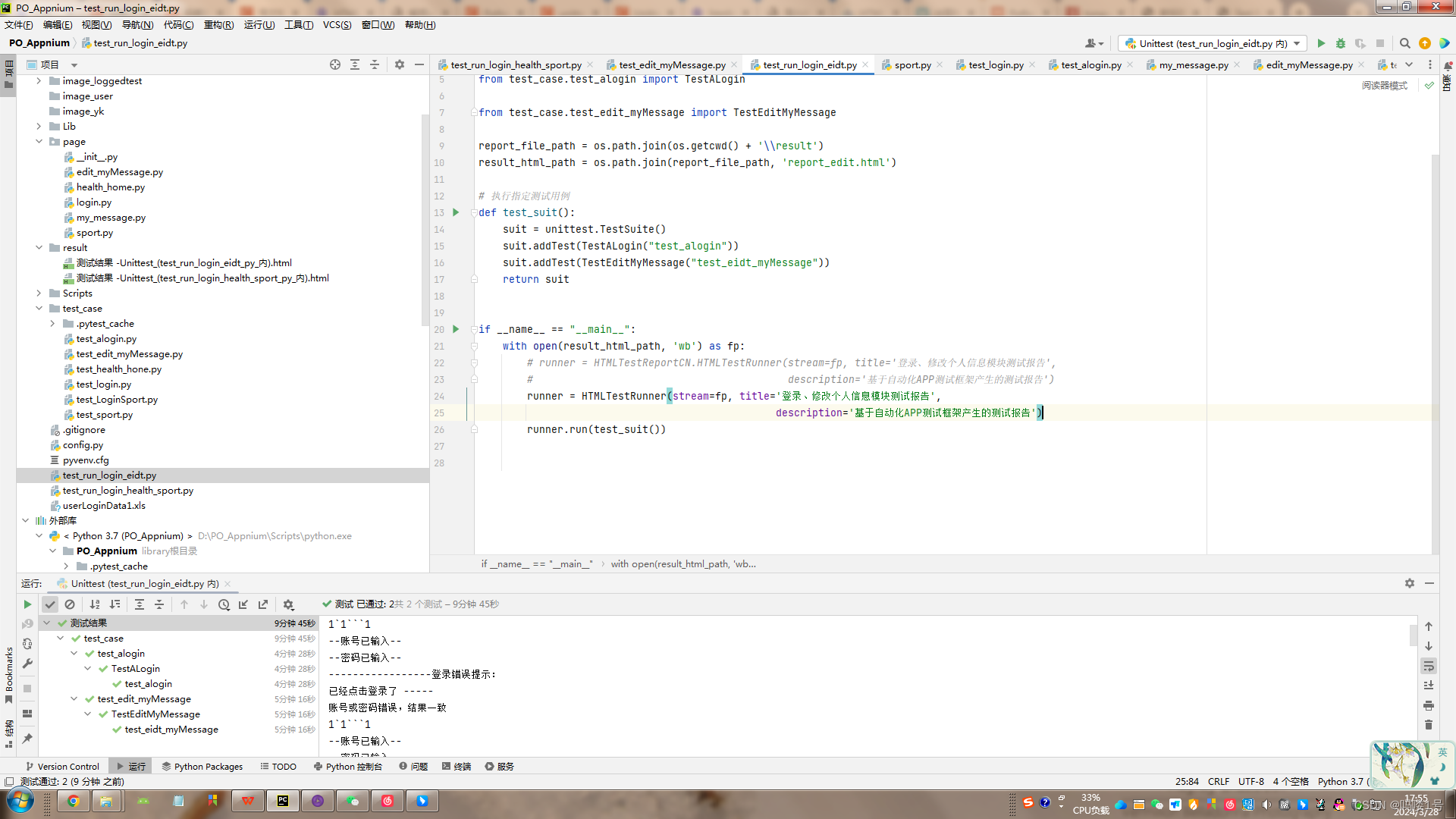
HTML报告:

--------------------------------------------
*日志添加:
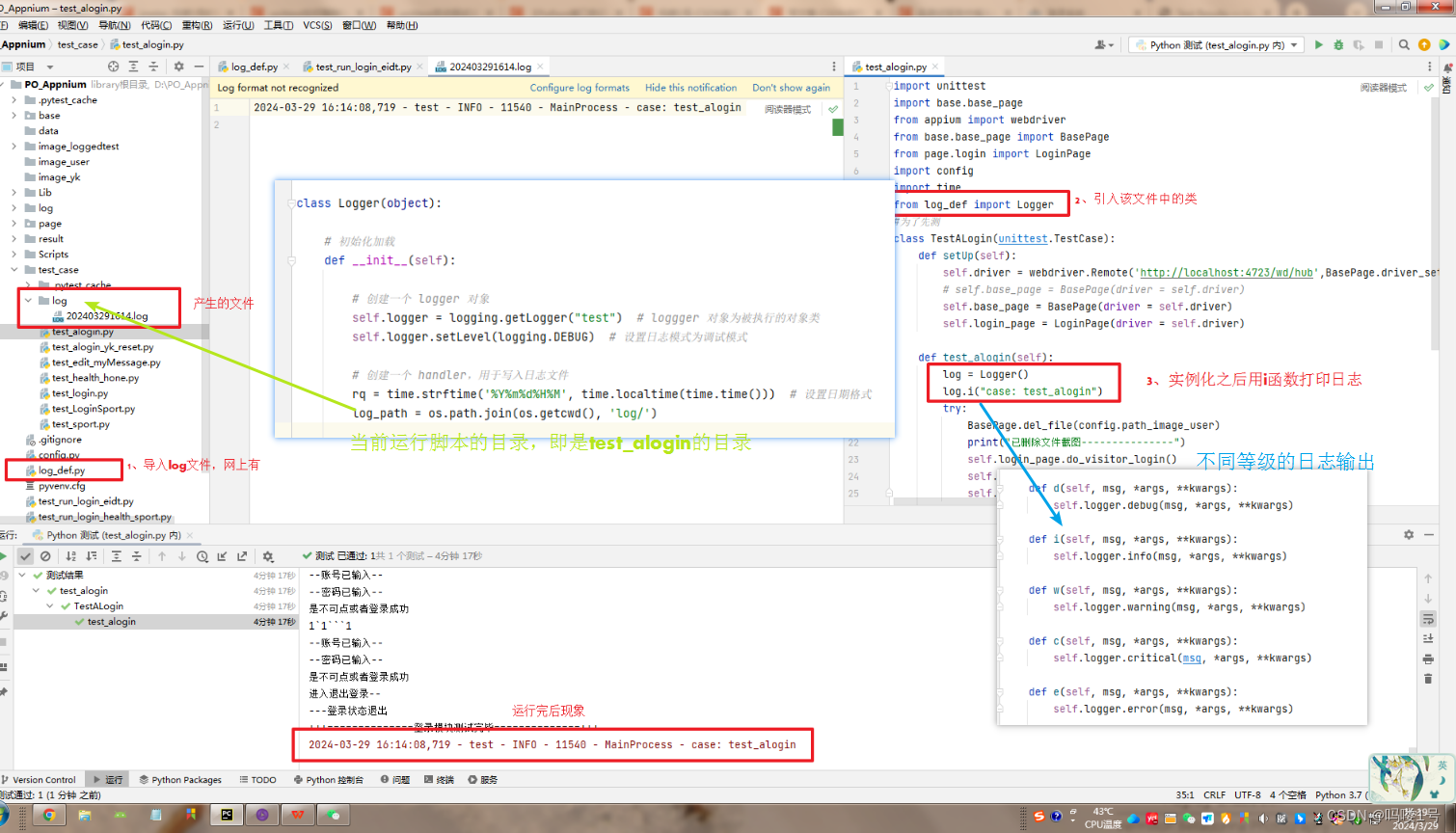
其实我感觉用在这个项目比较鸡肋哈哈哈
模型参考博文:
UI 自动化测试框架:PO 模式+数据驱动 【详解版】_po设计模式框架-CSDN博客
Appium PO模式UI自动化测试框架——设计与实践_po模式自动化框架-CSDN博客







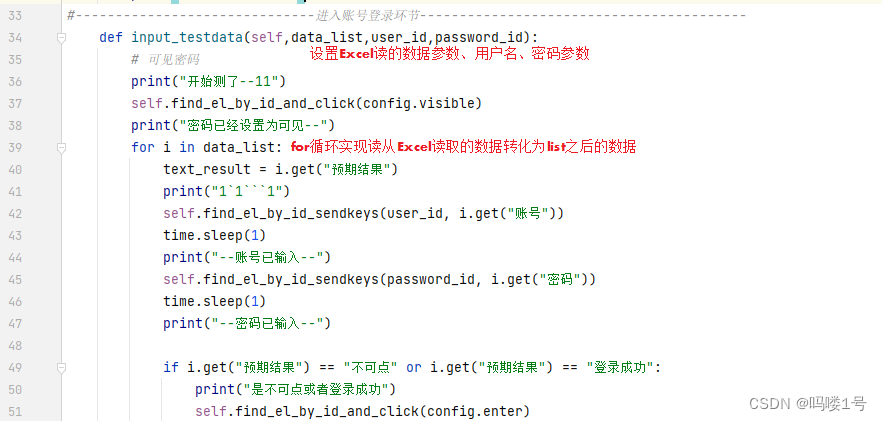













 130
130











 被折叠的 条评论
为什么被折叠?
被折叠的 条评论
为什么被折叠?








